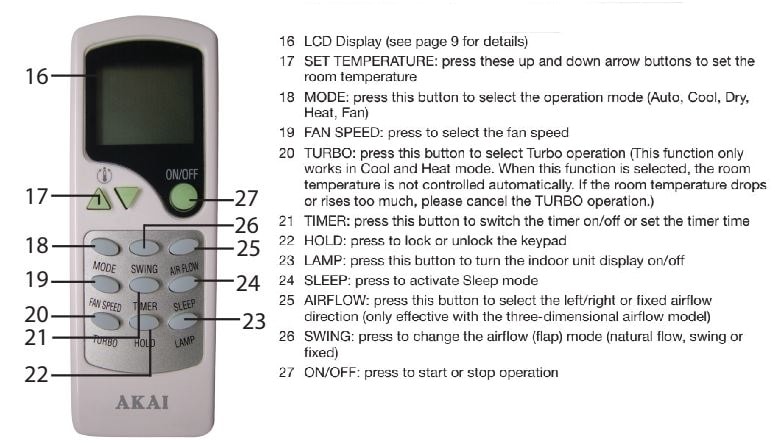This air conditioner is equipped with a self-diagnosis function to help you identify potential problems. Should you encounter problems with your air conditioner, contact our after sales support centre using the details on the bottom of the page.However, before calling for service, consult the selfdiagnosis information below.

| Error Code | Meaning |
|---|---|
| dF | Indicates “dF”or heating icon blinks. Defrost indication. Blinks once per second |
| Fan motor picture not running | Anti cold wind. Blinks once per second. |
| E2 | Room temperature sensor fault. Blinks once every 8 seconds. |
| E3 | Coil temperature sensor. Blinks twice every 8 seconds. |
| E8 | Indoor fan fault. Blinks 3 times every 8 seconds. |
| E5 | Outdoor feedback. Blinks 6 times every 8 seconds. |
| E7 | External feedback fault. Blinks 7 times every 8 seconds. |
| E0 | Open the door fault. Open the door fault. Blinks 3 times every 8 seconds. |
| E1 | Outdoor tube temperature sensor faults. Blinks 4 times every 8 seconds. |
| E6 | (EEPROM) Communication failures. Blinks 6 times every 8 seconds. |
| FF | Outdoor temperature exceeds scope (too cold). Blinks once per second. |

Akai Portable AC Troubleshooting
Problems: Error code “E1” in LED window
Causes: Environment temperature sensor is broken.
Suggest Solutions: Replace the temperature sensor
Problems: Error code “E2” in LED window
Causes: Temperature sensor on the evaporator is broken
Suggest Solutions: Replace the sensor
Problems: Error code “E3” in LED window
Causes: Cooling system malfunction caused by the lack of refrigerant
Suggest Solutions: Contact the local repairing technician directly
Problems: Error code “E4” in LED window the red FULL light is bright
Causes: Water tray is full in the heating mode, but the unit is still working
Suggest Solutions: Empty water in water plate
Problem: Air conditioner does not work.
Possible cause and solution:
- Power failure/disconnected/loose connections; check the power supply and ensure the unit is properly connected.
- Timer-on function is activated; cancel it.
- Damaged indoor/outdoor unit fan motor; call the after sales support line to arrange a service.
- Faulty compressor/thermomagnetic circuit breaker; call for service.
- Faulty protective device or fuse; call for service.
- Voltage is higher or lower than the required range; call for service.
- Electronic control board is damaged; call for service.
Problem: Remote control is unresponsive
Possible cause and solution:
- Remote control is too far away; move closer to the indoor unit
- Remote control batteries are flat; replace.
- Path to the signal receiver is blocked; remove obstructions
Problem: Cooling (Heating) efficiency is not good
Possible cause and solution:
- Unsuitable temperature setting — adjust fan speed.
- Blocked air intakes/ outlets — clear obstructions.
- Dirty air filter — clean the filter.
- Fan speed is set to LOW — increase.
- Other sources of heat in the room — check
Problem: Indoor unit does not work straight after restarting it
Possible cause and solution: This is not a fault. Once the air conditioner is stopped, you will have to wait for approximately 3 minutes before the unit can be restarted
Problem: Strange odour coming from the outlet
Possible cause and solution:
- Odour in the room (from building material, furniture or smoke) is recirculated
- Dirty air filter — clean the filter
Problem: Noise like running water when cooling
Possible cause and solution: Refrigerant is flowing inside the unit — no cause for concern
Problem: Mist is emitted when cooling
Possible cause and solution: Cold air used for rapid cooling of the air in the room may resemble fog — no cause for concern
Problem: Mist is emitted when heating
Possible cause and solution: Moisture from the defrosting process generates mist — no cause for concern.
Problem: Low noise is emitted during operation.
Possible cause and solution:
- A low hissing sound is caused by the refrigerant flowing.
- A low squeak sound is caused by the plastic parts expanding and contracting due to temperature fluctuations.
Problems with Wi-Fi connectivity
Problem: App does not show the air conditioner.
Possible cause and solution:
- Check and ensure you have Wi-Fi enabled on your smartphone.
- Check and ensure your smartphone and the air conditioner are connected to the same wireless router.
- If the air conditioner is correctly connected to the wireless router, the Wi-Fi indicator light on the display should be on
Problem: Remote control via smartphone does not work, despite correct connection
Possible cause and solution: Restart your AKAI Home App or reconnect your smartphone with the wireless router
Comments